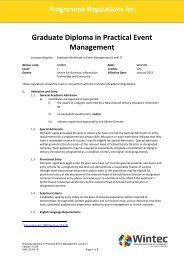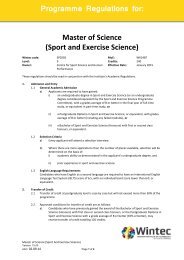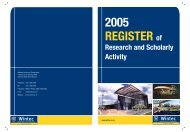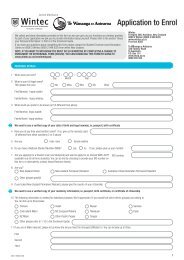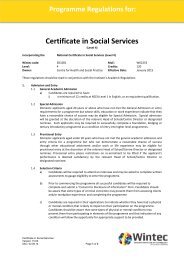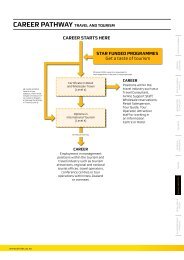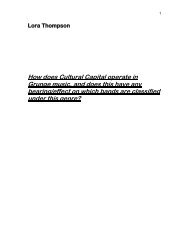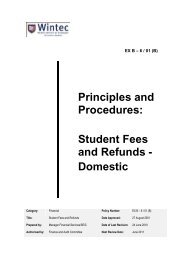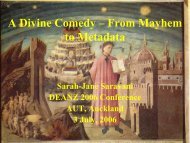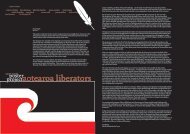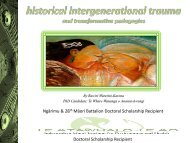2012 wintec annual report
2012 wintec annual report
2012 wintec annual report
Create successful ePaper yourself
Turn your PDF publications into a flip-book with our unique Google optimized e-Paper software.
NOTES TO THE<br />
FINANCIAL STATEMENTS<br />
For the year ended 31 December <strong>2012</strong>.<br />
If impairment evidence exists for investments at fair value through<br />
other comprehensive income, the cumulative loss (measured<br />
as the difference between the acquisition cost and the current<br />
fair value, less any impairment loss on that financial asset<br />
previously recognised in the surplus or deficit) recognised in other<br />
comprehensive income is reclassified from equity to the surplus<br />
or deficit.<br />
Equity instrument impairment losses recognised in the surplus or<br />
deficit are not reversed through the surplus or deficit.<br />
If in a subsequent period the fair value of a debt instrument<br />
increases and the increase can be objectively related to an<br />
event occurring after the impairment loss was recognised, the<br />
impairment loss is reversed in the surplus or deficit.<br />
Inventories<br />
Inventories are valued at the lower of cost and net realisable value.<br />
Inventories held for distribution or consumption in the provision of<br />
services that are not supplied on a commercial basis are measured<br />
at cost (using the FIFO method), adjusted when applicable, for any<br />
loss of service potential. Where inventories are acquired at no cost<br />
or for nominal consideration, the cost is the current replacement<br />
cost at the date of acquisition.<br />
Costs incurred in bringing each product to its present location<br />
and condition are accounted for as follows:<br />
Inventories held for resale-purchase cost on a first-in,<br />
first-out basis;<br />
Materials and consumables to be utilised for rendering of<br />
services- purchase cost on a first-in, first-out basis.<br />
Net realisable value is the estimated selling price in the ordinary<br />
course of activities less the estimated costs necessary to make<br />
the sale.<br />
Property, plant and equipment<br />
Property, plant and equipment consists of the following<br />
asset classes:<br />
• land<br />
• buildings<br />
• computer hardware<br />
• furniture and equipment<br />
• library collection<br />
• motor vehicles<br />
The measurement basis used for determining the gross carrying<br />
amount for each class of assets is as follows:<br />
Land is measured at fair value. Buildings and infrastructure<br />
are measured at fair value less accumulated depreciation and<br />
accumulated impairment losses.<br />
All other assets are measured at cost, less accumulated<br />
depreciation and impairment losses.<br />
Revaluation<br />
Land, buildings and infrastructure are revalued with sufficient<br />
regularity to ensure that their carrying amount does not differ<br />
materially from fair value and at least every three years.<br />
The carrying values of revalued assets are assessed <strong>annual</strong>ly to<br />
ensure that they do not differ materially from fair value. If there is<br />
evidence supporting a material difference, then the off-cycle asset<br />
classes are revalued.<br />
Revaluation of property, plant and equipment is carried out on a<br />
class of asset basis.<br />
The net revaluation results are credited or debited to other<br />
comprehensive income and accumulated to an asset revaluation<br />
reserve in equity for that class of asset. Where this would result<br />
in a debit balance in the asset revaluation reserve, this balance is<br />
not recognised in other comprehensive income but is recognised<br />
in the surplus or deficit. Any subsequent increase on revaluation<br />
that off-sets a previous decrease in value recognised in the surplus<br />
or deficit will be recognised first in the surplus or deficit up to<br />
the amount previously expensed, and then recognised in other<br />
comprehensive income.<br />
Additions<br />
The cost of an item of property, plant and equipment is recognised<br />
as an asset if, and only if, it is probable that future economic<br />
benefits or service potential associated with the item will flow<br />
to the Institute and Group and the cost of the item can be<br />
measured reliably.<br />
The costs of day-to-day servicing of property, plant, and equipment<br />
are recognised in the surplus or deficit as they are incurred.



